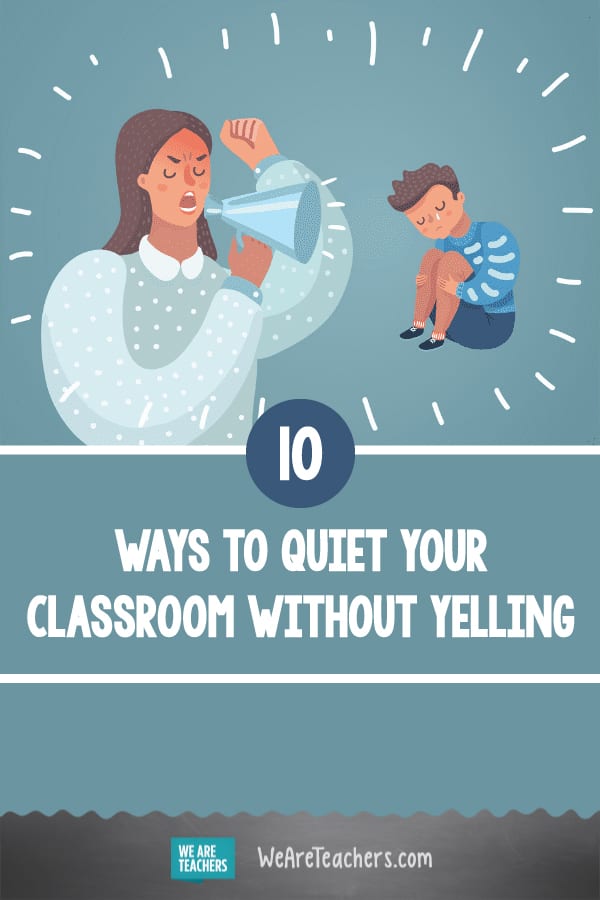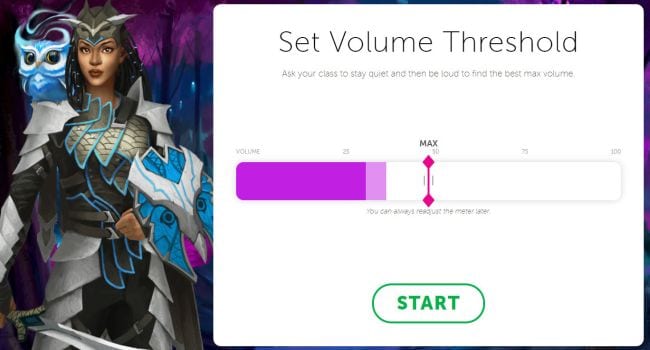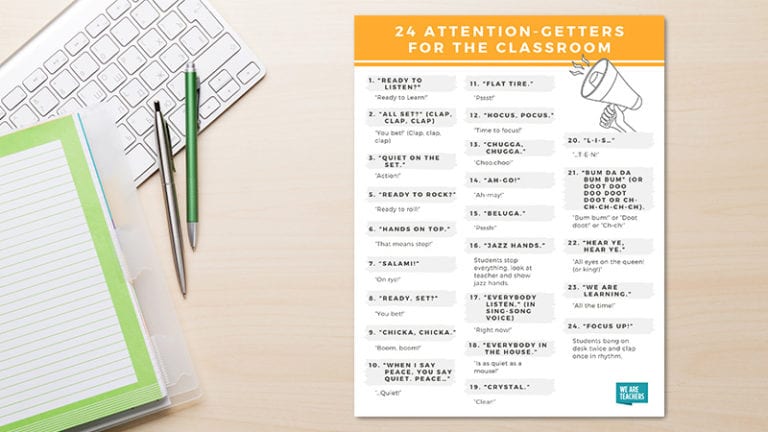How is it that some teachers seem to be able to manage their classrooms without ever needing to raise their voice? Is it some kind of magic? That’s the question teachers have been discussing in our WeAreTeachers HELPLINE group on Facebook: How can I stop yelling to get my class’s attention?
Yelling, it turns out, is rarely worth the trouble anyway. “I never yell anymore,” explains Nikki W. “My kids have had enough yelling in their lives and they learn to tune it out.” So how can you get them to listen if you stop yelling? Check out these ten teacher-tested tips that really work instead.
1. Try a classic call-and-response or clap-back.
Jordan A. recommends an age-old teacher favorite. “Make a call-and-response. Something like ‘Like a good neighbor’ and the kids say ‘State Farm is there’ back and then get quiet. You have to teach it, but after a bit it catches on and works like magic.” (Get more fun attention-getter phrases here.)
Elisabeth P. likes to give them a physical action as a response. “I quietly say, ‘If you can hear me, touch your nose. If you can hear me, cross your arms. If you can hear me, give me your best professor look, etc.’ After the first few, all students have joined in.
Clap-backs are another fun alternative. “My kids love a clap off,” says Gina A. “I clap different patterns for them to mimic. They always quiet right down and I always tell them how impressed I am with their ability to copy the hardest beats!”
2. Install a wireless doorbell.

This idea from sixth-grade teacher Heather M. is downright genius. “I bought a wireless doorbell and ring the bell as my quiet signal,” she shares. “Sometimes I have to ring it ten times before they get quiet, but it keeps me from ever raising my voice. There are a ton of different sounds to choose from, so I switch the chime every month or so to keep them from getting used to it and ignoring it too much. I’ve had kids comment that I’m the only teacher who never yells, and I’m proud of that. I used to end up yelling all the time when I tried other methods to get them quiet. The bell really works for me!” (Check out this $12 option from Amazon to try it yourself.)
[contextly_auto_sidebar]
3. Teach them to respond to hand signals.
Rebecca S. notes that the time out signal (arms above head with hands making a “T” shape) works at every level, including high school. “The kids put it up when they see you doing it and they’re supposed to stop talking. It takes a little while to get them into the swing of it, but it works.”
Try expanding your hand signals to communicate other commands too. Christina M. teachers her kids basic words in sign language like Yes, No, Stop, and Sit. See more classroom hand signal ideas here.
4. Shut off the lights.
This is another classic teaching strategy. Stop yelling and just turn off the lights instead, like Valeria T. “I like shutting lights off; it’s like they know to freeze and zip it.” If you’re in a classroom without windows and don’t want to plunge into total darkness, try turning off just one bank of lights or flashing them on and off a few times.
5. Monitor noise levels with an app.
Carol T. tipped us off to classroom noise monitoring apps. Choose an acceptable noise level and let the app do the work! Display the noise meter on the classroom screen to help kids monitor their own noise level. If they can’t manage to stay quiet, the app will warn them with a buzzer or other reminder. There are multiple free noise monitoring apps out there; we like Classcraft’s Volume Meter and the very popular Bouncy Balls.
6. Count down to quiet (or set a timer).
Giving kids time to transition from one activity to the next, rather than expecting instant silence, can be helpful. Terri M. says, “I count quietly backwards from 10 during transition times. Anyone not in their seat and ready does have a consequence.”
A countdown timer works too. “I use an online timer with a countdown buzzer for transitions,” explains Brita L. “I hold up the next activity—like if it’s a read-aloud, hold up the book. If they don’t respond, try a secondary signal—walking to groups holding the book, and saying this is what’s coming next, get ready.”
Timers work both ways, too. “I sit quietly and get my timer out,” says Nikki W. “However long it takes them to get quiet is how long they stay in [from recess]. Honestly I never even have to keep them in anymore because it ends up being like 20 seconds. They freak out when they see the timer and hurry up!”
7. Give them visual cues.
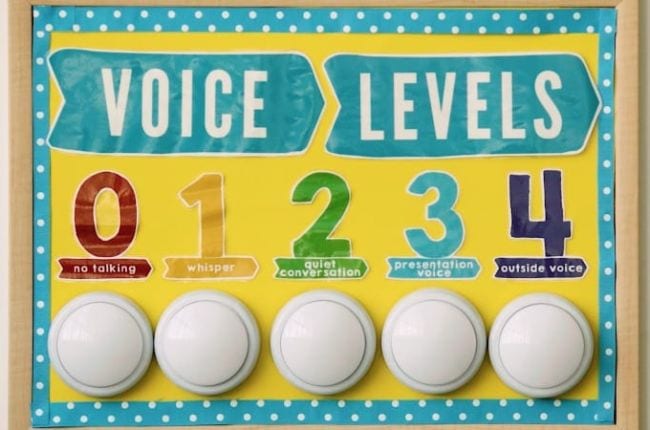
Make sure your students know what noise level is currently acceptable in the classroom. Create a voice level display using battery-operated tap lights and our free printable poster. Before you start an activity, tell your kids what noise level will be acceptable while they’re working and turn on the appropriate light as a reminder.
8. Reward the quiet ones.
Elisabeth P. suggests, “Start saying thank you to the kids who are listening and are looking at you. In a normal tone of voice, say, ‘Thank you, Johnny, for being the first one ready to listen. Thank you, Susie, for being ready to listen.’ They LOVE being the first one to be noticed. Soon everyone joins them and looks at me for directions.”
Fifth grade teacher Courney S. plays a code word game. “When I felt it was getting noisy (usually right before big holidays) I would bring in a candy or a privilege for the day. As I taught I would just say in the same volume as I was or a bit quieter the code word is _______. Then I would ask who heard the code word. I would have 3 kids whisper it to me for the team point. Whichever team won before lunch or dismissal got the mystery treat or prize. The key is to do it randomly and a few times each at a quieter voice and the class quiets down with you so they can win!”
9. Get quieter, not louder.
Tammy H. explains, “I was told a long time ago: If you yell, they will get louder to over-talk you. If you talk in a normal tone students will stop and listen. It works in my classroom.” Chantel J. agrees, “It takes a conscious effort to do so but after a while it becomes habit.”
Sometimes it’s best to just go silent and wait. “When they’re noisy and not listening,” says Carolyn C., “I’ll stand there and look at them, and then the clock, and then them, and then the clock… and I’ll wait. It only takes a few kids to notice that I’ve stopped talking over them and then it’s ‘SHHHH! LOOK!! MS. C’S WAITING!!’ and peer pressure takes over to do the right thing.”
Paige T. showed her students how much her voice really matters in the classroom. “With a class that refused to let me teach, we went silent for a week, so they realized how much having extra help and instructions helped. After reading part of The Odyssey alone, they got the point.”
10. Learn some new approaches to discipline.
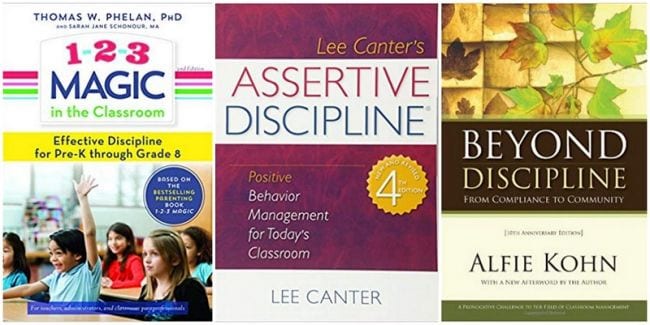
If you still just can’t seem to stop yelling in the classroom, explore some new options. Here are a few recommendations from other teachers:
- Responsive Classroom
- Assertive Discipline, by Lee Canter
- Beyond Discipline, by Alfie Kohn
- 1-2-3 Magic in the Classroom, by Thomas Phelan and Sarah Jane Schonour
What strategies have you used to stop yelling in the classroom? Come and share in our WeAreTeachers HELPLINE group on Facebook.
Plus, one teacher’s success story of how she learned to stop yelling.
This article includes Amazon affiliate links. WeAreTeachers receives a tiny bit of the purchase price when you buy through these links, but we only recommend products we really love.
